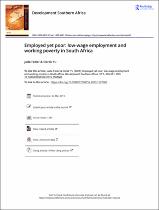| dc.contributor.author | Feder, Jade | |
| dc.contributor.author | Yu, Derek | |
| dc.date.accessioned | 2023-02-08T09:14:09Z | |
| dc.date.available | 2023-02-08T09:14:09Z | |
| dc.date.issued | 2020 | |
| dc.identifier.citation | Feder, J., & Yu, D. (2020). Employed yet poor: Low-wage employment and workingpoverty in South Africa. Development Southern Africa, 37(3), 363–381. https://doi.org/10.1080/0376835X.2019.1597682 | en_US |
| dc.identifier.issn | 1470-3637 | |
| dc.identifier.uri | https://doi.org/10.1080/0376835X.2019.1597682 | |
| dc.identifier.uri | http://hdl.handle.net/10566/8381 | |
| dc.description.abstract | Working poverty exists worldwide and has shown an increase inprevalence over the past few decades. Over the years, there hasbeen an increase in the number and severity of low-wageemployment, which in turn contributes significantly to poverty.Whilst paid employment has generally been considered as thepredominant means to survivefinancially, salaries may be too lowto maintain reasonable living standards. South African research onlow-wage employment and working poverty in particular, are rare.Using data from thefirst four waves of the National IncomeDynamics Study, this studyfills the existing research gap byexamining low-wage employment, working poverty, and low-wage poverty. The empiricalfindings indicated that all threegroups are predominantly lowly-educated, middle-aged Africanfemale employees involved in elementary occupations in theinformal sector. | en_US |
| dc.language.iso | en | en_US |
| dc.publisher | Taylor and Francis Group | en_US |
| dc.subject | Employment | en_US |
| dc.subject | Poverty | en_US |
| dc.subject | South Africa | en_US |
| dc.subject | Informal sector | en_US |
| dc.subject | Finance | en_US |
| dc.title | Employed yet poor: Low-wage employment and workingpoverty in South Africa | en_US |
| dc.type | Article | en_US |

